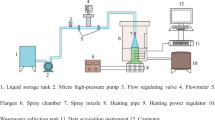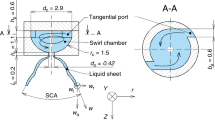Abstract
In this study, the heat transfer characteristics of nanofluids used in spray cooling systems were examined. Three nanofluids, i.e., Cu, CuO, and Al2O3, respectively, with volume fractions ranging from 0.1% to 0.5%, as well as different volume fractions of a surfactant Tween 20, were used. In addition, their contact angles were measured to examine the heat-transfer characteristics. Under the same experimental conditions, with the increase in the volume fraction of the Cu nanoparticles from 0.1% to 0.5%, the maximum heat flux qmax increased from 3.36 MW/m2 to 3.48 MW/m2 from the impinging central point to r = 30 mm (r is the distance from the impingement point), and the corresponding temperature of qmax increased from 400°C to 420°C. Results revealed that with increasing Tween 20 concentrations, the contact angle decreased because of the decrease in the surface tension of nanofluids and improvement of the wetting ability, and the corresponding qmax increased from 3.48 MW/m2 to 3.94 MW/m2 at the impact central point.
Similar content being viewed by others
Abbreviations
- a :
-
thermal diffusivity/m2·s−1
- C :
-
specific heat capacity/J·kg−1·K−1
- q :
-
heat flux/MW·m−2
- q :
-
max maximum heat flux/MW·m−2
- r :
-
the distance from the impingement point
- T :
-
temperature/K
- T :
-
a actual temperature/K
- T :
-
c calculation temperature/K
- T :
-
max temperature at maximum heat flux/K
- t :
-
the time/s
- t :
-
max the time at maximum heat flux/s
- x :
-
thickness/m
References
Cox S.D., Hardy S.J., Parker D.J., Influence of runout table operation setup on hot strip quality, subject to initial strip condition: heat transfer issues. Ironmaking & Steelmaking, 2001, 28(5): 363–372.
Chester N.L., Wells M.A., Prodanovic V., Effect of inclination angle and flow rate on the heat transfer during bottom jet cooling of a steel plate. Journal of Heat Transfer, 2012, 134(12): 122201.
Xie J.L., Zhao R., Duan F., et al., Thin liquid film flow and heat transfer under spray impingement. Applied Thermal Engineering, 2012, 48: 342–348.
Wongcharee K., Chuwattanakul V., Eiamsa-ard S., Heat transfer of swirling impinging jets with TiO2-water nanofluids. Chemical Engineering and Processing: Process Intensification, 2017, 114: 16–23.
Wang Y., Liu M., Liu D., et al., Experimental study on the effects of spray inclination on water spray cooling performance in non-boiling regime. Experimental Thermal and Fluid Science, 2010, 34(7): 933–942.
Aamir M., Qiang L., Xun Z., et al., Ultra fast spray cooling and critical droplet daimeter estimation from cooling rate. Journal of Power and Energy Engineering, 2014, 2(04): 259–270.
Agrawal C., Lyons O.F., Kumar R., et al., Rewetting of a hot horizontal surface through mist jet impingement cooling. International Journal of Heat and Mass Transfer, 2013, 58(1-2): 188–196.
Suresh S., Venkitaraj K.P., Selvakumar P., et al., Synthesis of Al2O3–Cu/water hybrid nanofluids using two step method and its thermo physical properties. Colloids and Surfaces A: Physicochemical and Engineering Aspects, 2011, 388(1-3): 41–48.
Chakraborty S., Sarkar I., Ashok A., et al., Thermo-physical properties of Cu-Zn-Al LDH nanofluid and its application in spray cooling. Applied Thermal Engineering, 2018, 141: 339–351.
Kolsi L., Hussein A., Borjini M., et al., Computational analysis of three-dimensional unsteady natural convection and entropy generation in a cubical enclosure filled with water-Al2O3 nanofluid. Arabian Journal for Science and Engineering, 2014, 39(11): 7483–7493.
Al-Rashed A., Kalidasan K., Kolsi L., et al., Mixed convection and entropy generation in a nanofluid filled cubical open cavity with a central isothermal block. International Journal of Mechanical Sciences, 2018, 135: 362–375.
Fan L.W., Li J.Q., Li D.Y., et al., The effect of concentration on transient pool boiling heat transfer of graphene-based aqueous nanofluids. International Journal of Thermal Sciences, 2015, 91: 83–95.
Karimzadehkhouei M., Shojaeian M., Şendur K., et al., The effect of nanoparticle type and nanoparticle mass fraction on heat transfer enhancement in pool boiling. International Journal of Heat and Mass Transfer, 2017, 109: 157–166.
Sundar L.S., Sharma K.V., Singh M.K., et al., Hybrid nanofluids preparation, thermal properties, heat transfer and friction factor–a review. Renewable and Sustainable Energy Reviews, 2017, 68: 185–198.
Lee D., Irmawati N., Investigation on fluid flow and heat transfer characteristics in spray cooling systems using nanofluids. Dynamics, 2015, 9(8): 1409–1413.
Jha J., Ravikumar S., Tiara A., et al., Ultrafast cooling of a hot moving steel plate by using alumina nanofluid based air atomized spray impingement. Applied Thermal Engineering, 2015, 75: 738–747.
Mohapatra S.S., Ravikumar S.V., Verma A., et al., Experimental investigation of effect of a surfactant to increase cooling of hot steel plates by a water jet. Journal of Heat transfer, 2013, 135(3): 032101.
Mohapatra S.S., Ravikumar S.V., Andhare S., et al. Experimental study and optimization of air atomized spray with surfactant added water to produce high cooling rate. Journal of Enhanced Heat Transfer, 2012, 19(5): 397–408.
Clay M.A., Miksis M.J., Effects of surfactant on droplet spreading. Physics of Fluids, 2004, 16(8): 3070–3078.
Gradeck M., Ouattara A., Maillet D., et al., Heat transfer associated to a hot surface quenched by a jet of oil-inwater emulsion. Experimental Thermal & Fluid Science, 2011, 35(5): 841–847.
Drzazga M., Lemanowicz M., Dzido G., et al., Preparation of metal oxide-water nanofluids by two-step method. Inżynieria I Aparatura Chemiczna, 2012, 51(5): 213–215.
Ravikumar S.V., Jha J.M., Sarkar I., et al., Mixed-surfactant additives for enhancement of air-atomized spray cooling of a hot steel plate. Experimental Thermal and Fluid Science, 2014, 55: 210–220.
Zhang X., Basaran O.A., Dynamic surface tension effects in impact of a drop with a solid surface. Journal of Colloid and Interface Science, 1997, 187(1): 166–178.
Jeong Y.H., Chang W.J., Chang S.H., Wettability of heated surfaces under pool boiling using surfactant solutions and nano-fluids. International Journal of Heat and Mass Transfer, 2008, 51(11-12): 3025–3031.
Sarafraz M.M., Kiani T., Hormozi F., Critical heat flux and pool boiling heat transfer analysis of synthesized zirconia aqueous nano-fluids. International Communications in Heat and Mass Transfer, 2016, 70: 75–83.
Khaleduzzaman S.S., Mahbubul I.M., Shahrul I.M., et al., Effect of particle concentration, temperature and surfactant on surface tension of nanofluids. International Communications in Heat and Mass Transfer, 2013, 49: 110–114.
Yang Y.M., Maa J.R., Pool boiling of dilute surfactant solutions. Journal of Heat Transfer, 1983, 105(1): 190–192.
Chol S.U.S., Estman J.A., Enhancing thermal conductivity of fluids with nanoparticles. Website: https://www.osti.gov/servlets/purl/196525 (accessed in 2018).
Hwang Y.J., Ahn Y.C., Shin H.S., et al., Investigation on characteristics of thermal conductivity enhancement of nanofluids. Current Applied Physics, 2006, 6(6): 1068–1071.
Xue Q.Z., Model for effective thermal conductivity of nanofluids. Physics Letters A, 2003, 307(5-6): 313–317.
Teja A.S., Beck M.P., Yuan Y., et al., The limiting behavior of the thermal conductivity of nanoparticles and nanofluids. Journal of Applied Physics, 2010, 107(11): 114319.
Ravikumar S.V., Jha J.M., Sarkar I., et al., Enhancement of heat transfer rate in air-atomized spray cooling of a hot steel plate by using an aqueous solution of non-ionic surfactant and ethanol. Applied Thermal Engineering, 2014, 64(1-2): 64–75.
Bhattacharya P., Samanta A., Chakraborty S., Spray evaporative cooling to achieve ultra fast cooling in runout table. International Journal of Thermal Sciences, 2009, 48(9): 1741–1747.
Crafton E., Black W., Heat transfer and evaporation rates of small liquid droplets on heated horizontal surfaces. International Journal of Heat and Mass Transfer, 2004, 47(6-7): 1187–1200.
Ma X., Su F., Chen J., et al., Heat and mass transfer enhancement of the bubble absorption for a binary nanofluid. Journal of Mechanical Science and Technology, 2007, 21(11): 1813–1818.
Karwa N., Experimental study of water jet impingement cooling of hot steel plates. tuprints, Darmstadt, Germany, 2012.
Tseng A.A., Bellerová H., Pohanka M., et al., Effects of titania nanoparticles on heat transfer performance of spray cooling with full cone nozzle. Applied Thermal Engineering, 2014, 62(1): 20–27.
Cheng L., Mewes D., Luke A., Boiling phenomena with surfactants and polymeric additives: a state-of-the-art review. International Journal of Heat and Mass Transfer, 2007, 50(13-14): 2744–2771.
Acknowledgments
This research was jointly supported by National Key R & D Plan (Project No. 2017YFB0305103), National Natural Science Foundation of China (Grant No. 51404058), the fundamental research funds for the central universities (Grant No. N150704005), and the open project of the RAL at Northeastern University (Grant No. 2016006).
Author information
Authors and Affiliations
Corresponding author
Rights and permissions
About this article
Cite this article
Wang, B., Liu, Z., Zhang, B. et al. Effect of Nanoparticle Type and Surfactant on Heat Transfer Enhancement in Spray Cooling. J. Therm. Sci. 29, 708–717 (2020). https://doi.org/10.1007/s11630-020-1212-7
Received:
Published:
Issue Date:
DOI: https://doi.org/10.1007/s11630-020-1212-7




